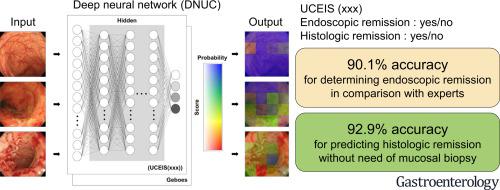Gastroenterology ( IF 29.4 ) Pub Date : 2020-02-12 , DOI: 10.1053/j.gastro.2020.02.012 Kento Takenaka 1 , Kazuo Ohtsuka 1 , Toshimitsu Fujii 1 , Mariko Negi 2 , Kohei Suzuki 1 , Hiromichi Shimizu 1 , Shiori Oshima 3 , Shintaro Akiyama 1 , Maiko Motobayashi 1 , Masakazu Nagahori 1 , Eiko Saito 1 , Katsuyoshi Matsuoka 1 , Mamoru Watanabe 1

|
Background & Aims
There are intra- and interobserver variations in endoscopic assessment of ulcerative colitis (UC) and biopsies are often collected for histologic evaluation. We sought to develop a deep neural network system for consistent, objective, and real-time analysis of endoscopic images from patients with UC.
Methods
We constructed the deep neural network for evaluation of UC (DNUC) algorithm using 40,758 images of colonoscopies and 6885 biopsy results from 2012 patients with UC who underwent colonoscopy from January 2014 through March 2018 at a single center in Japan (the training set). We validated the accuracy of the DNUC algorithm in a prospective study of 875 patients with UC who underwent colonoscopy from April 2018 through April 2019, with 4187 endoscopic images and 4104 biopsy specimens. Endoscopic remission was defined as a UC endoscopic index of severity score of 0; histologic remission was defined as a Geboes score of 3 points or less.
Results
In the prospective study, the DNUC identified patients with endoscopic remission with 90.1% accuracy (95% confidence interval [CI] 89.2%–90.9%) and a kappa coefficient of 0.798 (95% CI 0.780–0.814), using findings reported by endoscopists as the reference standard. The intraclass correlation coefficient between the DNUC and the endoscopists for UC endoscopic index of severity scoring was 0.917 (95% CI 0.911–0.921). The DNUC identified patients in histologic remission with 92.9% accuracy (95% CI 92.1%–93.7%); the kappa coefficient between the DNUC and the biopsy result was 0.859 (95% CI 0.841–0.875).
Conclusions
We developed a deep neural network for evaluation of endoscopic images from patients with UC that identified those in endoscopic remission with 90.1% accuracy and histologic remission with 92.9% accuracy. The DNUC can therefore identify patients in remission without the need for mucosal biopsy collection and analysis. Trial number: UMIN000031430
中文翻译:

深度神经网络的开发和验证,用于准确评估溃疡性结肠炎患者的内窥镜图像。
背景与目标
溃疡性结肠炎(UC)的内窥镜评估中观察者之间和观察者之间存在差异,通常会收集活检样本进行组织学评估。我们寻求开发一种深度神经网络系统,以对来自UC患者的内窥镜图像进行一致,客观和实时的分析。
方法
我们建立了一个用于评估UC(DNUC)算法的深度神经网络,该研究使用了2014年1月至2018年3月在日本的一个中心(训练集)接受结肠镜检查的2012年UC患者的40,758例结肠镜检查图像和6885例活检结果。我们在一项前瞻性研究中验证了DNUC算法的准确性,该研究对2018年4月至2019年4月进行结肠镜检查的875例UC患者进行了前瞻性研究,其中包括4187例内窥镜图像和4104例活检标本。内镜缓解定义为严重程度评分为0的UC内镜指数;组织学缓解定义为Geboes评分不超过3分。
结果
在前瞻性研究中,根据内镜医师报告的结果,DNUC以90.1%的准确度(95%的置信区间[CI] 89.2%–90.9%)和kappa系数为0.798(95%的CI 0.780–0.814)确定了内镜缓解的患者。作为参考标准。DNUC和内镜医师对UC内镜严重程度评分的组内相关系数为0.917(95%CI 0.911-0.921)。DNUC以92.9%的准确率(95%CI 92.1%–93.7%)识别出组织学缓解的患者;DNUC和活检结果之间的卡伯系数为0.859(95%CI 0.841–0.875)。
结论
我们开发了一个用于评估UC患者内窥镜图像的深度神经网络,该方法可识别出内镜缓解率(准确率90.1%)和组织学缓解率(92.9%)。因此,DNUC无需粘膜活检收集和分析即可识别缓解的患者。试用编号:UMIN000031430


























 京公网安备 11010802027423号
京公网安备 11010802027423号